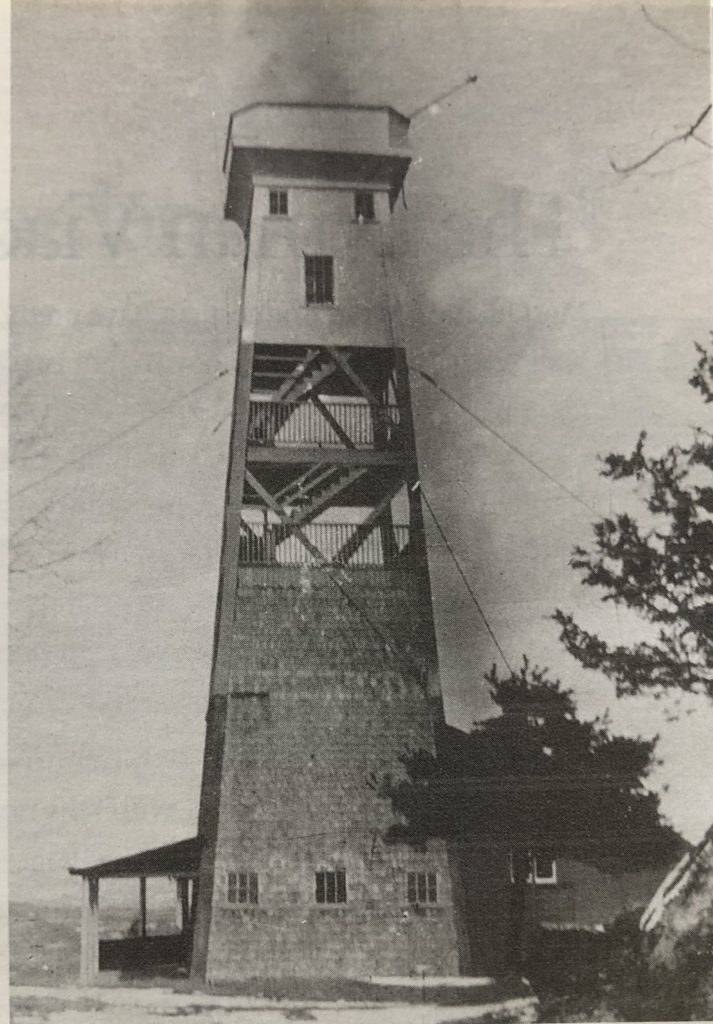
M. H. Bartlett’s tower commanded a spectacular view of the Connecticut River Valley from Talcott Mountain in Tariffville. Simsbury Historical Society
By Brenda J. Miller
(c) Connecticut Explored Inc. SUMMER 2008
Subscribe/Buy the Issue!
Two stone pillars on the side of Mountain Road in Tariffville mark the carriage path that ascends Talcott Mountain to what was once a popular tourist attraction, and is now an access point for the Metacomet Trail. To hike the Metacomet Trail from here is to take a trek back to a time when M.H. Bartlett’s tower resort ruled the summit and commanded the view.
Over the years, five towers have stood on Talcott Mountain. Hartford philanthropist, amateur architect, and founder of the Wadsworth Atheneum Daniel Wadsworth built two towers on his summer estate, the first in 1810, and the second in 1839 after the first blew down in a storm. The second tower fell victim to fire in 1864. Matthew Henry Bartlett, better known as M.H. Bartlett, followed with two towers of his own, in1867 and 1889. The fifth tower, built by wine and spirits mogul Gilbert Heublein in 1914, still stands today.
Bartlett was born in 1833 to a congregational minister and his wife and spent most of his youth in Avon in the shadow of Talcott Mountain. Bartlett likely hiked the mountain and was familiar with the Wadsworth tower. But it was a visit to the Prospect House, a popular hotel and tourist destination at the summit of Mt. Holyoke in Massachusetts that inspired him to build his first tower.
In his 30s, with his health failing, Bartlett returned home thinking the fresh country air would do him good. Having come from a reasonably well-to-do family and having worked a number of years before going into the resort business, he was able to buy land on the mountain. For his first tower he partnered with his nephew, Charles A. Kellogg, but eventually bought him out. Modeling his mountain retreat after the financially successful Prospect House, Bartlett built his first overlook a few hundred yards south of where Heublein Tower stands today in Avon, successfully launching his first for-profit tourist resort on July 4, 1867.
Bartlett’s tower resort offered visitors croquet, swings, a piano and dancing platform with tables in a grove for picnics, a telescope to observe the view, and a Summer House for refreshmentsWhen he sold it and the land in 1889 and realized the new owner had no intention of opening the tower to the public, or keeping the tower at all, Bartlett stepped out of his self-imposed retirement and built his second Bartlett Tower farther north, in Tariffville. His first tower, as Bartlett feared, was torn down by the new owner, New York millionaire Robert Hoe.
Bartlett’s Tariffville tower was bigger and grander than his first, boasting a view of 1,200 square miles from 600 feet above sea level. Standing 70 feet high, the tower had guest bedrooms on two floors and an observation deck at its top, surrounded by a railing and open on all four sides. There was a 50-by-70-foot pavilion with tables and chairs, a bowling lane, dance floor, and piano. Field glasses (early binoculars) and “Claude Lorraine” glasses—whose tinted lenses and convex mirror allowed tourists to view the landscape as if it were a miniature landscape painting—were provided. An attendant on the observation deck pointed out places of interest to guests looking through a telescope. A nearby grove with tables and seats for large parties, swings, croquet, quoits, and a seesaw satisfied the more active visitors.
This tower was also more accessible than the first. It was less than a third of a mile from the train station. By 1895, a total of 250,000 people had visited one or both of his towers. His most frequent and faithful guests were Hartford residents Samuel Clemens, Charles Dudley Warner, and the Rev. Joseph H. Twichell of Asylum Hill Congregational Church.
Bartlett sold his Tariffville resort to Antoinette Eno Wood in 1898. She turned it into a private retreat and renamed it Manahoose Lodge. The wooden tower was destroyed by fire in 1936.
Today, if you are looking for a vestige of this bygone era, go back to the beginning—to the stone pillars on the side of this dead-end street in Tariffville—and follow the carriage road’s fading imprint up the mountain. You’ll have to bring your own binoculars, but you’ll see the same magnificent view.
Explore!
The Mountain Road trailhead of the Metacomet Trail is located at the junction of Routes 189 and 315 in Tariffville, where there is limited roadside parking.
Read all of our stories about the historic Connecticut landscape on our TOPICS page
